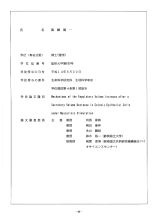Mechanisms of the regulatory volume increase after a secretory volume decrease in colonic epithelial cells under muscarinic stimulation Mechanisms of the Regulatory Volume Increase after a Secretory Volume Decrease in Colonic Epithelial Cells under Muscarinic Stimulation
この論文にアクセスする
この論文をさがす
著者
書誌事項
- タイトル
-
Mechanisms of the regulatory volume increase after a secretory volume decrease in colonic epithelial cells under muscarinic stimulation
- タイトル別名
-
Mechanisms of the Regulatory Volume Increase after a Secretory Volume Decrease in Colonic Epithelial Cells under Muscarinic Stimulation
- 著者名
-
眞鍋, 健一
- 著者別名
-
マナベ, ケンイチ
- 学位授与大学
-
総合研究大学院大学
- 取得学位
-
博士 (理学)
- 学位授与番号
-
甲第639号
- 学位授与年月日
-
2002-09-30
注記・抄録
博士論文
Volume regulation is one of the most important cell functions to maintain cell homeostasis in a variety of physiological and pathological conditions, where cells are subject to osmotic perturbation. Although colon crypts have been reported to shrink during Cl<SUP>-</SUP> secretion in response to secretagogue stimulation, it is not yet clear whether or how individual secretory cells located in colon crypts restore their cell volume. To study this, he visualized individual cells in the crypt isolated from the guinea pig distal colon using two-photon laser scanning microscopy, and their volume changes in response to carbachol (CCh), a cholinergic agonist, were compared with those of a human colonic epithelial T84 cell line. Both T84 cells and fundus crypt cells, but not upper crypt cells, showed shrinkage (termed a secretory volume decrease: SVD) after CCh stimulation, and surprisingly, even under continuous stimulation by CCh, they recovered their original cell volume (called a regulatory volume increase: RVI) after SVD. The SVD response to CCh was antagonized by atropine, indicating that the response is mediated by stimulation of muscarinic receptors. An increase in the intracellular free Ca<SUP>2+</SUP> concentration was found by fura-2 fluoro- ratiometry during these volume changes in both cell types. Chelation of intracellular Ca<SUP>2+</SUP> by BAPTA abolished the SVD in T84 cells. The RVI, but not the preceding SVD, was found to be thoroughly abolished by bumetanide in T84 and crypt enterocytes. Also, removal of either Na<SUP>+</SUP>, K<SUP>+</SUP>, or Cl<SUP>-</SUP> from the extracellular solution abolished the RVI. These results suggest that the RVI process is accomplished by ionic osmolyte influx via bumetanide-sensitive Na<SUP>+</SUP>-K<SUP>+</SUP>-2Cl<SUP>-</SUP> cotransporters. It is suggested that the Na<SUP>+</SUP>-K<SUP>+</SUP>-2Cl<SUP>-</SUP> cotrantsporter is NKCC1, because this isoform was originally cloned from T84 cells and is known to be expressed in a wide variety of secretory epithelial cells, while another isoform, NKCC2, is known to be expressed exclusively in the kidney.<br /> When cells change their volume, water must move across the plasma membrane. Both the CCh- induced SVD and the RVI after SVD were inhibited by methylmethanethiosulfonate (MMTS), a sulfhydry1 non-mercury aquaporin blocker, in T84 cells and colonic enterocytes, suggesting that the water transport is mediated by a certain aquaporin water channel. Studies by RT-PCR aud immunocytochemistry both showed abundant expression of AQP3 in T84 cells. Antisense knockdown of AQP3 was found to block the SVD-RVI responses to CCh in T84 cells. These results indicate that the AQP3 water channel is involved in both the SVD and following RVI processes in T84 cells. It is also suggested that AQP3 water channels are essential for the SVD in guinea pig colon crypts, since AQP3 is the most abundantly expressed aquaporin isoform in the gastrointestinal tract. <br /> The RVI after SVD is a distinct type of cell volume regulation in secretory cells, and it is supposed to be important in maintaining the secretory function is colonic epithelial cells. The present study elucidated the ionic mechanism and demonstrated an involvement of water channel in this volume regulation process.
総研大甲第639号
